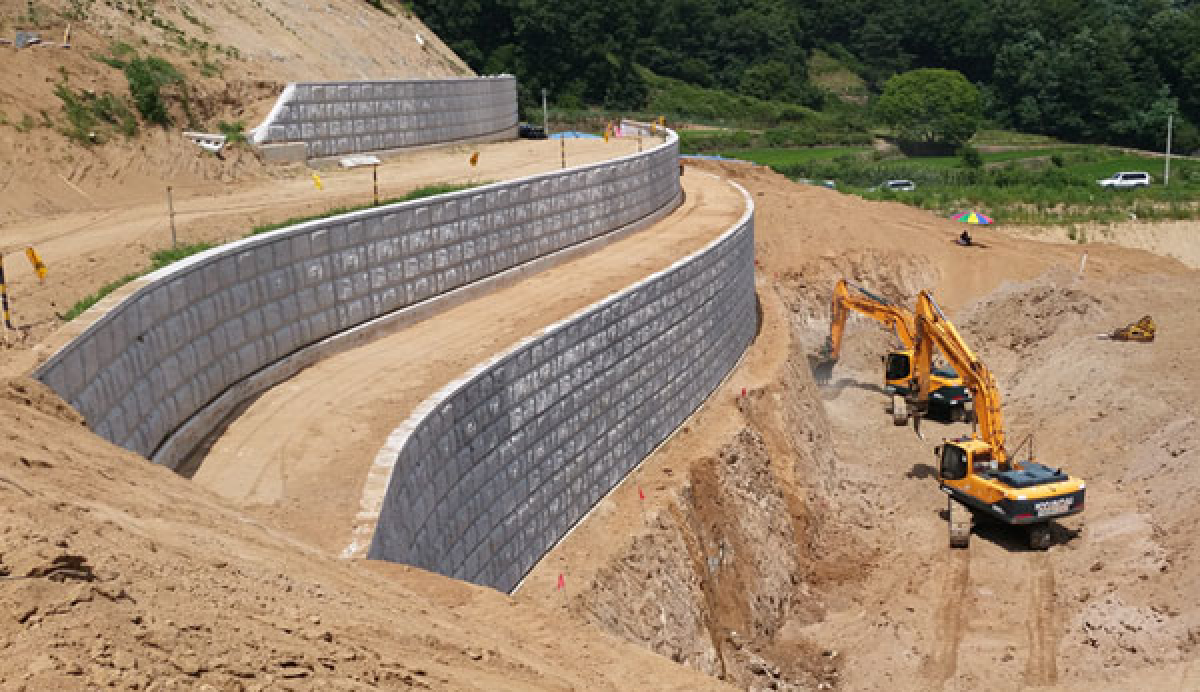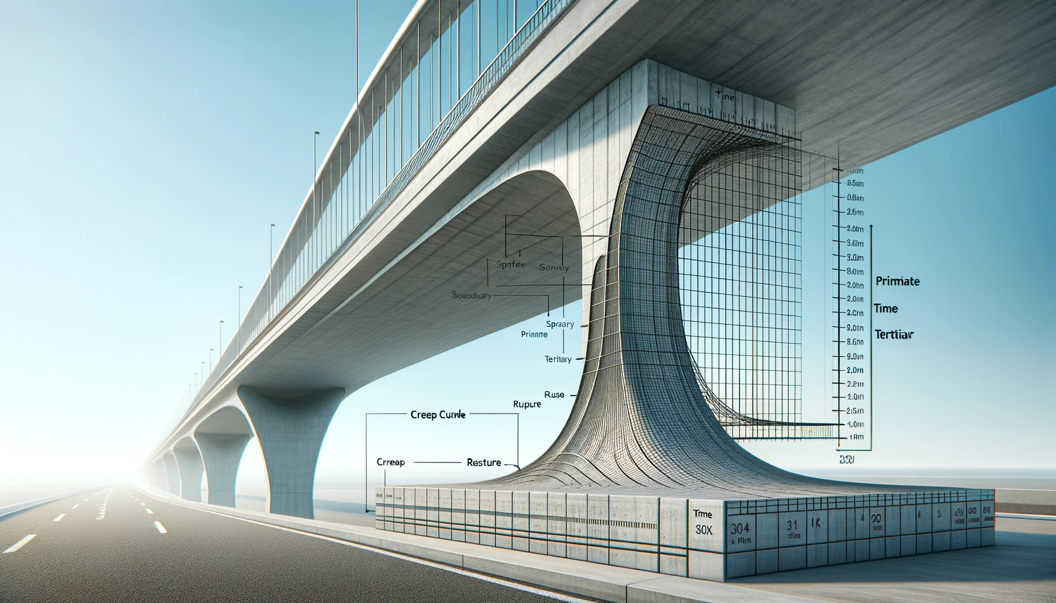(Click the table of contents to navigate to the detailed content)

1. Introduction
2. Coulomb's Horizontal Earth Pressure
(1) The basic assumptions of Coulomb's earth pressure theory.
(2) Coulombs' earth pressure formula
3. Coulomb's wedge theory
(2) Active earth Pressure
(2) Passive Earth Pressure
(3) Trial wedge method using Excel
4. Conclusion
(1) Comparing the results with the soil pressure calculation using Excel
(2) Appropriateness of the earth pressure coefficient when the back slope is greater than the internal friction angle
References
Topic
1. Introduction
The horizontal earth pressure can be defined as the ratio of the effective horizontal stress to the effective vertical stress.
K = σh / σv
Horizontal earth pressure can be classified into earth pressure at rest, active earth pressure, and passive earth pressure.
A brief explanation of the three earth pressures is as follows.
Earth pressure at rest
→ Earth pressure acting in the horizontal direction without any lateral displacement of the soil.
Active earth pressure
→ Earth pressure acting in the horizontal direction where the backfill soil expands and fails, such that the structure moves away from the backfill soil.
Passive earth pressure
→ Earth pressure acting in the horizontal direction where the backfill soil contracts and fails, such that the structure moves towards the backfill soil.
The magnitude of horizontal earth pressure can be categorized as follows
Active earth pressure < Earth pressure at rest < Passive earth pressure
%20Coulombs%20wedge%20theory%20of%20earth%20pressure/Coulombs%20wedge%20theory%20(1).png?width=886&height=447&name=Coulombs%20wedge%20theory%20(1).png)
The Coulomb and Rankine formulas are well-known for horizontal earth pressures.
Let's take a look at the Coulomb earth pressure.
Who is Coulomb?
%20Coulombs%20wedge%20theory%20of%20earth%20pressure/Coulombs%20wedge%20theory%20(2).png?width=870&height=1125&name=Coulombs%20wedge%20theory%20(2).png)
Charles-Augustine de Coulomb (1736~1806)
French physicist and engineer.
Coulomb Proposed the theory of active and passive earth pressures (Coulomb's Wedge Theory) for the lateral earth pressure acting on a wall.
He is known for Coulomb's law, which describes the magnitude of the electrostatic force or Coulombic force.
The SI unit for electric charge, the coulomb, is named after him.
What happened when Coulomb published his Wedge Theory (1776)?
It was the Joseon Dynasty in Korea and the Declaration of Independence in the United States.
2. Coulomb's Horizontal Earth Pressure
(1) The basic assumptions of Coulomb's earth pressure theory.
1) Soil is isotropic and homogeneous and has both internal friction and cohesion.
2) The failure surface is plane.
3) The failure wedge is a rigid body.
4) The pressure plane is a flat surface.
5) There is a wall friction in the pressure plane.
6) There is no cohesion in the soil.
7) The earth pressure is applied at a point 1/3 of the height of the wall.
(2) Coulombs' earth pressure formula
The following is an extract from Principles of Geotechnical Engineering.(Ninth Edition, P575~P582)
1) Coulomb's active earth pressure
%20Coulombs%20wedge%20theory%20of%20earth%20pressure/Coulombs%20wedge%20theory%20(3).png?width=1500&height=1000&name=Coulombs%20wedge%20theory%20(3).png)
active earth pressure coefficient
%20Coulombs%20wedge%20theory%20of%20earth%20pressure/Coulombs%20wedge%20theory%20(4).png?width=886&height=124&name=Coulombs%20wedge%20theory%20(4).png)
2) Coulomb's passive earth pressure
%20Coulombs%20wedge%20theory%20of%20earth%20pressure/Coulombs%20wedge%20theory%20(5).png?width=713&height=840&name=Coulombs%20wedge%20theory%20(5).png)
Passive earth pressure coefficient
%20Coulombs%20wedge%20theory%20of%20earth%20pressure/Coulombs%20wedge%20theory%20(6).png?width=826&height=123&name=Coulombs%20wedge%20theory%20(6).png)
※ Points to consider when applying Coulomb's earth pressure formula
In Coulomb's earth pressure formula, if the back face inclination of the structure(α) is greater than the internal friction angle of soil(ϕ'), the value [sin(ϕ' - α)] in the root of the denominator becomes a negative imaginary number.
Therefore, when applying Coulomb's earth pressure formula, the back face inclination of the structure(α) must be less than the internal friction angle of soil.
This is also applicable for calculations using the wedge method.
%20Coulombs%20wedge%20theory%20of%20earth%20pressure/Coulombs%20wedge%20theory%20(7).png?width=886&height=124&name=Coulombs%20wedge%20theory%20(7).png)
Korea Design Standard - retaining wall design example (2008) recommends the following design guidelines depending on the backfill material used for the retaining wall.
-
For loose cohesionless soil, sandy soil with fines content.
-
The slope angle is 1 (vertical): 1.8 (horizontal),
-
The internal friction angle of the soil is 30°,
-
The unit weight of soil is 19 kN/m3.
-
-
For the coarse-grained sandy soil is
-
Slope 1 (vertical) : 1.5 (horizontal),
-
The internal friction angle of the soil is 35°,
-
The unit weight is 20 kN/m3.
-
The back fill material of the retaining wall was classified according to the back face inclination of the structure.
This is because if the back face inclination is greater than the internal friction angle of the backfill material, instability of the slope may occur.
3. Coulomb's wedge theory
Coulomb's earth pressure formula was derived for the case of a constant slope.
However, Coulomb's wedge method has the advantage of being able to calculate earth pressures in cases where the back slope is not constant or when a load is applied to the back surface.
(2) Active earth Pressure
The process of calculating the active earth pressure using Coulomb's trial wedge method involves the following steps:
%20Coulombs%20wedge%20theory%20of%20earth%20pressure/Coulombs%20wedge%20theory%20(8).png?width=1962&height=1142&name=Coulombs%20wedge%20theory%20(8).png)
① Line segment AB = Earth pressure acting surface
② The angle of inclination of the backfill is β from the horizontal.
③ The angle between the horizontal plane and line AB is α.
④ The height of the wall is H.
⑤ Line segment AC is the assumed failure surface, and the angle between the horizontal plane and line AC is θ.
⑥ The weight of the earth wedge is W = γ A.
where A is the area of (triangle ABC).
Area of the earth wedge (triangle ABC) = 1/2 × AC × BD
AC: the length of the soil failure surface
BD: the length of the straight line drawn at right angles to AC
Using the principle of sin,
%20Coulombs%20wedge%20theory%20of%20earth%20pressure/Coulombs%20wedge%20theory%20(9).png?width=2200&height=862&name=Coulombs%20wedge%20theory%20(9).png)
In Figure 3-1 Coulomb's active earth pressure - (b) Force Triangle, using the sin principle, Pa can be calculated.
%20Coulombs%20wedge%20theory%20of%20earth%20pressure/Coulombs%20wedge%20theory%20(10).png?width=2200&height=202&name=Coulombs%20wedge%20theory%20(10).png)
※ Sin principle
The three angles A, B, and C and the three side lengths a, b, and c of triangle ABC are determined by the following equation.
%20Coulombs%20wedge%20theory%20of%20earth%20pressure/Coulombs%20wedge%20theory%20(11).png?width=2200&height=202&name=Coulombs%20wedge%20theory%20(11).png)
%20Coulombs%20wedge%20theory%20of%20earth%20pressure/Coulombs%20wedge%20theory%20(12).png?width=700&height=636&name=Coulombs%20wedge%20theory%20(12).png) Figure 3-2 The sin principle
Figure 3-2 The sin principle
Also, Pa can be found by solving the equilibrium equation with ∑Fx=0 and ∑Fy=0, so use whatever method you are comfortable with.
Substitute (Eq. 3-1) into (Eq. 3-2) to simplify, and the following equation are obtained.
%20Coulombs%20wedge%20theory%20of%20earth%20pressure/Coulombs%20wedge%20theory%20(13).png?width=734&height=166&name=Coulombs%20wedge%20theory%20(13).png)
(2) Passive Earth Pressure
Let's draw the force equilibrium for Coulomb's passive earth pressure.
%20Coulombs%20wedge%20theory%20of%20earth%20pressure/Coulombs%20wedge%20theory%20(14).png?width=1922&height=1142&name=Coulombs%20wedge%20theory%20(14).png)
The passive earth pressure calculation is similar to the active earth pressure calculation.
%20Coulombs%20wedge%20theory%20of%20earth%20pressure/Coulombs%20wedge%20theory%20(15).png?width=2200&height=202&name=Coulombs%20wedge%20theory%20(15).png)
In Figure 3-3 Coulomb's active earth pressure - (b) Force Triangle, using the sin principle, Pp can be calculated.
%20Coulombs%20wedge%20theory%20of%20earth%20pressure/Coulombs%20wedge%20theory%20(16).png?width=2200&height=202&name=Coulombs%20wedge%20theory%20(16).png)
%20Coulombs%20wedge%20theory%20of%20earth%20pressure/Coulombs%20wedge%20theory%20(17).png?width=2200&height=504&name=Coulombs%20wedge%20theory%20(17).png)
(3) Trial wedge method using Excel
Assuming the failure angle of the soil wedge using Excel and drawing a graph, it can be expressed as shown in the below figure.
%20Coulombs%20wedge%20theory%20of%20earth%20pressure/Coulombs%20wedge%20theory%20(18).png?width=1374&height=1136&name=Coulombs%20wedge%20theory%20(18).png)
4. Conclusion
(1) Comparing the results with the soil pressure calculation using Excel
Let's compare the soil pressure coefficient values in the soil mechanics book and the values computed in Excel.
1) Active earth pressure
%20Coulombs%20wedge%20theory%20of%20earth%20pressure/Coulombs%20wedge%20theory%20(19).png?width=821&height=311&name=Coulombs%20wedge%20theory%20(19).png)
Angle α = 90° between the wall and the horizontal plane
Back slope β = 0
Friction angle of the wall δ = 0°.
Ka= 0.3333
%20Coulombs%20wedge%20theory%20of%20earth%20pressure/Coulombs%20wedge%20theory%20(20).png?width=2028&height=1104&name=Coulombs%20wedge%20theory%20(20).png)
2) Passive earth pressure
%20Coulombs%20wedge%20theory%20of%20earth%20pressure/Coulombs%20wedge%20theory%20(21).png?width=821&height=357&name=Coulombs%20wedge%20theory%20(21).png)
Angle α = 90° between wall and horizontal plane
Back slope β = 0
Friction angle of the wall δ = 0°.
Kp= 3.000
%20Coulombs%20wedge%20theory%20of%20earth%20pressure/Coulombs%20wedge%20theory%20(22).png?width=2028&height=1104&name=Coulombs%20wedge%20theory%20(22).png)
(2) Appropriateness of the earth pressure coefficient when the back slope is greater than the internal friction angle
Let's see if the back slope is larger than the internal friction angle.
Angle α = 90° between wall and horizontal plane
Back slope β = 34° > Internal friction angle ϕ = 30°.
Wall friction angle δ = 0°.
1) Active soil pressure
The coefficient of active earth pressure is calculated as Ka= 6.162.
This value is incorrect since the coefficient cannot be greater than 1.0.
%20Coulombs%20wedge%20theory%20of%20earth%20pressure/Coulombs%20wedge%20theory%20(23).png?width=2028&height=1104&name=Coulombs%20wedge%20theory%20(23).png)
2) Passive earth pressure
The passive earth pressure coefficient is calculated as Kp= 10.784.
%20Coulombs%20wedge%20theory%20of%20earth%20pressure/Coulombs%20wedge%20theory%20(24).png?width=2028&height=1104&name=Coulombs%20wedge%20theory%20(24).png)
Based on the above results, It is important to note that in Coulomb's earth pressure coefficient formula, it is not possible to directly calculate the earth pressure when the back slope is greater than the internal friction angle.
The trial wedge method can be used to calculate the case where the back slope is larger than the internal friction angle, but the value is incorrect and cannot be used.
If the back slope exceeds the internal friction angle, the cohesive force should be considered to determine the effective earth pressure.
However, the adhesion force is a value obtained through soil tests, and it is difficult to consider the appropriate adhesion force in the field because the properties of the soil may change over time.
Therefore, adhesion is generally not considered for soil pressure calculations.
References
Wadsworth, Inc, 2018, Braja M Das, Khaled Sobhan, Principles of Geotechnical Engineering Ninth Edition
Topic
#Coulomb
#trial wedge
# Coulomb earth pressure
# Earth pressure
# Horizontal earth pressure
/4Newbie.png)
Currently I am working as an structural engineer in South Korea.
Mainly involved in bridge and underground structure design projects.
For the analysis programs, I mainly work with MIDAS Civil.
Hope you will find the contents helpful.

![Design and Practical Examples of Baseplates and Anchor Rods [sample download]](https://2495902.fs1.hubspotusercontent-na1.net/hubfs/2495902/%EC%8D%B8%EB%84%A4%EC%9D%BC22.png)
![Understanding Drafting Standards [ Drawing download ]](https://2495902.fs1.hubspotusercontent-na1.net/hubfs/2495902/%EC%8D%B8%EB%84%A4%EC%9D%BC24.png)
![Key Changes in ACI 318-19: A New Standard for Structural Design [ PDF download]](https://2495902.fs1.hubspotusercontent-na1.net/hubfs/2495902/%EC%8D%B8%EB%84%A4%EC%9D%BC21-1.png)
![Design and Practical Examples of Lug design(ASME BTH-1) [sample download]](https://2495902.fs1.hubspotusercontent-na1.net/hubfs/2495902/%EC%8D%B8%EB%84%A4%EC%9D%BC20-1.png)





